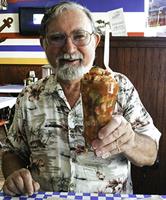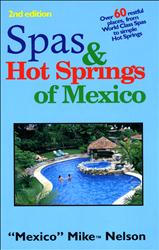Since this story was written in the early 1990s, a lot has changed in Batopilas, Creel, and the Copper Canyon in general. The entire road from Creel to Batopilas is now paved. The area is pretty much under the control of the cartels, but you can still visit – they leave tourists alone. I drove there in 2016 and had a good time. Eventually, I will write an article about it. This is a story – not an article.
This isn’t meant to be a travel article about hotels and how to visit Creel and Batopilas. There are way too many articles like that on the Internet. This is a relative nonfiction story meant as a slice of life at a certain time. And even I admit that there is cartel activity in the area. Creel is fine and the other towns between there and Divisadero, but Batopilas itself is a little iffy, according to people I trust who’ve been there.
Creel — Start of the Road To Batopilas
Creel and Batopilas have come a long way in the last few years. Whether it is forward or backward depends on your point of view. Some purists decry the fact that there are now a few hotels in all price ranges, restaurants, a couple of bars, and guides. Old-timers (those who “discovered” the place before 1960) liked it when it was more primitive. Now it has electricity, a few doctors and dentists, and a pharmacy. Whenever some “old-timer” starts talking about the good old days, I like to throw that in.
I bring this up here because Creel is on the verge of changing dramatically. Many of the changes have already occurred. I’ve met people there who already think there are too many tourists. My own, very personal opinion is that change is not always bad. In my opinion, putting up a high-rise hotel that blocks the view of the natural attraction of a place defiles it. Of course, that’s just my opinion. For those who work at the high-rise, it is a good thing. For those who have never seen natural beauty before, they don’t know better. Change is change. For those who have to live in primitive places, running water and electricity and doctors are pretty nice things to have. For those “old-timers” who died or got very sick because of a lack of medical care, changing a little earlier would have been a nice thing. So, when you go to Creel, just be grateful that you got there when you did. Live for today.
We all find our special places on this earth and want to protect them. Many of us dislike high-rise hotels and the sun & fun mentality that “ruins” a place according to our standards. I feel that this is a little arrogant. We find a place when we find a place, no sooner, no later. There are others, less fortunate or simply younger than we, who do not “discover” it until many years later. Let them enjoy what they find without telling them that their special place has already been “ruined.” Lighten up.
Creel is not pronounced the way you think. It’s pronounced the way it looks. It’s only one syllable. CREE’LL will do fine. Most folks want to make it into two syllables and add a very textbook Spanish pronunciation. They are wrong. The town was named for Enrique Creel, a former governor, and statesman. The town was planned to have a population of half Tarahumara and half Mexicans. It became a logging town and a stop on the railroad, and somehow the balance got out of kilter.
Creel has a dusty, Wild West feeling to it. The log cabins and elevated board sidewalks add to the feeling. While it is a relative metropolis compared to Batopilas, for someone arriving in the Canyon for the first time, it seems pretty primitive. Today it has a goodly selection of hotels and a few restaurants and even a place to buy slide film and sometimes black and white. (See resource guide). Some movies have been filmed here, and the casts stay at the Parador de la Montana. Middle-class travelers like the excellent Best Western Creel with its hot tub, sauna, masseuses, and good restaurant.
Backpackers fancy Margaritas Casa de Huespedes Margarita built a “new” place (which will be called “Margarita’s new place” long after I am dead), which is more upscale with nice cabins, a courtyard, and an atmosphere. When I first met her, she asked if the people who read the books I write had money. I replied that many of them had more than I did (not much of an accomplishment — I invested in pesos just before the last devaluation). She brightened up and gave me a grand tour of the place. At the time, it was run by an Irishman and his wife. He’s still around, so if you want to brush up on your Gaelic, seek him out. There’s also a charming place with cabins and an RV park called Pension Creel. The owners of this place called me at Sanborn’s to let me know they were building an RV park. That was a welcome change from the number of places that I have to ferret out a year or two after they are built.
This came from a reader, Martin. Mike, it’s been a few years (2001), but Hotel Margarita, in Creel, Chi, was great. You can have the swamps and all that water. I like the hills, the desert, and the canyons.
The hotel stands out because it’s inexpensive, has good food (you can eat in the kitchen), and welcomes families or ‘hips’ (who usually stay in a common room). Two floors, a small courtyard, on the square, and much of the food is locally grown, meaning ranchero hucksters knock on the door. It was, then, a hundred bucks for a week with two meals included/per day. They get a lot of tourists from the US, Europe, and Australia for ecotourism. A homey bunch works there. Tell the ladies to not hang out with ‘Don’ Juan 🙂
Creel is still something of a cow town. It’s on the rail, so if taking the bus is not an adventure for someone, then the train is there. The drive was easy with good roads. Remember, tho, that these are mountain roads and the weather can go from sunny to Tlatoc out looking for his victims. The barrancas are awesome and a must-see, but the Tarahumara tend to stare (being a redskin, to me, means they’re being insulting, and it is to them, as well).
Finding Estela’s kitchen took some doing. I was updating the town one cold December day when it was drizzling and gray. Carl Franz had told me about her place. He said there was probably no sign (he was right). I turned down a side street and the smell of good food drew me to the tiny, tidy kitchen. While Doña Estela wasn’t there, Srta. Manela and her assistant were. In that low-ceilinged room with a big white stove in the middle of the kitchen area and a big black pot of soup bubbling away, I forgot about the cold.
I found the guide Chris Hall by accident, too. I was checking out Burgers Creel, a popular place in Batopilas. A fellow lounging by the counter informed me that I could speak English if that was my want. I asked a few questions and he answered me. I fessed up to the fact that I was updating a book and gave him my card. Folks, it was one of those experiences that I live for. He looked surprised and said, “You’re “Mexico” Mike! I’ve heard of you. Do you need any guides to put in your book?”
Now, I may be (quite) a bit of an egotist, but I’m not that bad a fellow. I’d spent the last six days with a reporter from the New York Times who was doing a story on me. Pressure is having a Times reporter write down everything you say or do for six days. Allen Myerson is a great guy, and the story will probably be complimentary, but one never knows. (It was, and Allen is no longer with the Times, but I don’t think that is my fault).
As usual, I had gotten lost, and broken my rule about driving at night. I was cold and wet and tired. With those few words, Chris erased all the tension and made me feel like a million bucks. You just never know how a small act of kindness might affect another human being. Chris, I thank you. I replied that I had heard of him too and was looking for him. I had about three minutes to chat before I had to leave. I was truly sorry that we didn’t get to know each other because I could tell he was a good guy with a good soul. When you live on the road, you learn to develop your instincts about people. Some day I will tell you about Amazon, but that’s another book.
You’ll see several Tarahumara around Batopilas, in their flowing white robes or dresses and long, straight black hair. Creel is rather a center for them, with the Mission store across from the plaza and the train station. It was developed by Father Verplanken, a New Orleans missionary Jesuit priest who has done much to improve their lives. One of the things he brought was modern irrigation systems, which helped make farming a little easier and improve the hardscrabble life of the Tarahumaras. The mission store buys crafts from the Tarahumara at reasonable prices and sells them to tourists. They have the best selection of crafts anywhere in the Canyon. While their prices may occasionally be somewhat higher than some other stores, when you buy there, you can be assured that a fair amount of your money is going to the artisan who made the item. The rest of it goes to improve the medical care and life in general of the Tarahumara.
The Tarahumara are not as serious as they look. They are quite fond of ribald jokes, or so folks who know them a lot better than I do, tell me. You probably know them for their running prowess and the fact that they can run the shoes off gringo ultra-marathoners. Using only primitive tools, they make some excellent violins that are true musical instruments. I met a fellow on the train who introduced them to better tools and is teaching them to make their tools.
1992-95 were rough years for them. The worst drought in forty years killed many of them. At Christmas time, 1994, the biggest rainstorm in forty years roared through the Canyon, but that was only a drop in an empty bucket. I nearly slugged some tourists I met on the train because they were complaining about the rain having inconvenienced them — ugly Americans. The drought kills the children first. They die of malnutrition-related illnesses. By the time they show up at mission or government clinics, they are usually too weak to be treated. The Noble Savage concept neglects to mention the number of people who die because they have to walk for days to a medical facility. Tuberculosis is a big killer under normal conditions, aggravated by living in caves.
Some people say that the best thing modern society can do for the Tarahumara is to leave them alone and let them live as they wish. Others say a little medical care and education could improve their lives. Others say it ruins their lives. Me, I don’t know, but it sure is sad to see babies die. If you feel that doing something is a good idea, see the Resource guide for people who are reputable and can use your cash donations.
Around Creel are the Recohuata hot springs, hiking trips into the Canyon, the bus to Batopilas, the great view of the rim at Divisadero, Tejaban, and other attractions.
No matter how little time you spend in Creel, you won’t forget the experience. ———————————————————————-
Mike spent some time in Creel, but fortunately, some of the folks there are starting to forget the experience.



